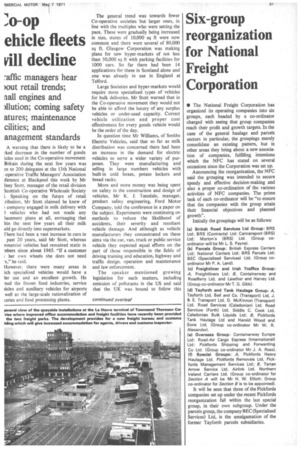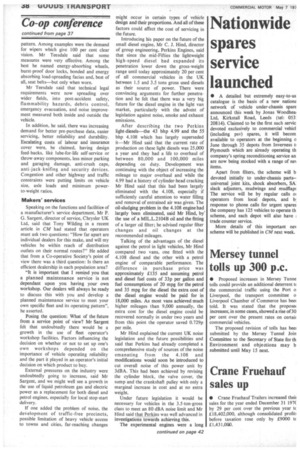:o-op ehicle fleets vill decline
Page 39

Page 40

Page 44

If you've noticed an error in this article please click here to report it so we can fix it.
7affic managers hear )out retail trends; nail engines and illution; coming safety atures; maintenance cilities; and anagement standards
A warning that there is likely to be a 7ked decrease in the number of goods idles used in the Co-operative movement Britain during the next few years was !,n to 200 delegated at the 13th National -operative Traffic Managers' Association iference at Blackpool this week by Mr Iney Stott, manager of the retail division Scottish Co-operative Wholesale Society I. Speaking on the future of retail :ribution, Mr Stott claimed he knew of company engaged in milk delivery with 1 vehicles who had not made any lacement plans at all, envisaging that hin the next few years all their milk aid go directly into supermarkets.
f here had been a vast increase in cars in past 20 years, said Mr Stott, whereas nmercial vehicles had remained static in nbers since about 1965. "If a customer ; her own wheels she does not need .s," he said.
However, there were many areas in ich specialized vehicles would have a ler use and an excellent growth. He ned the frozen food industries, service ticks and auxiliary vehicles for airports well as the large-scale rationalization of (cries and food processing plants.
The general trend was towards fewer Co-operative societies but larger ones, in line with the multiples who were setting the pace. These were gradually being increased in size, stores of 10,000 sq ft were now common and there were several of 80,000 sq ft. Glasgow Corporation was making plans for new hyper-markets of not less than 50,000 sq ft with parking facilities for 1000 cars. So far there had been 14 applications for these in Scotland alone and one was already in use in England at Telford.
Large Societies and hyper-markets would require more specialized types of vehicles for bulk deliveries. Mr Stott warned that in the Co-operative movement they would not be able to afford the luxury of any surplus vehicles or under-used capacity. Correct vehicle utilization and proper cost effectiveness for every goods vehicle would be the order of the day.
In question time Mr Williams, of Smiths Electric Vehicles, said that so far as milk distribution was concerned there had been an increase in the demand for electric vehicles to serve a wider variety of purposes. They were manufacturing and selling in large numbers vehicles with built-in cold boxes, potato lockers and bread racks.
More and more money was being spent on safety in the construction and design of vehicles, Mr K. J. Teesdale, manager, product safety engineering, Ford Motor Company, told the conference in a paper on the subject. Experiments were continuing on methods to reduce the likelihood of accidents, their severity and resultant vehicle damage. And although as vehicle manufacturers they concentrated on these aims via the car, van, truck or public service vehicle they expected equal efforts on the part of those responsible in the fields of driving training and education, highway and traffic design, operation and maintenance and law enforcement.
The speaker mentioned growing legislation for such matters, including emission of pollutants in the US and said that the UK was bound to follow this pattern. Among examples were the demand for wipers which give 100 per cent clear vision. Mr Teesdale said that some measures were very effective. Among the best he named energy-absorbing wheels, burst-proof door locks, bonded and energy absorbing load-spreading facias and, best of all, seat belts—but only when worn.
Mr Teesdale said that technical legal requirements were now spreading over wider fields, into post-accident safety, flammability hazards, debris control, emergency evacuation, and noise improvement measured both inside and outside the vehicle.
In addition, he said, there was increasing demand for better pre-purchase data. easier servicing, better reliability and durability. Escalating costs of labour and insurance cover were, he claimed, having design feed-backs, like lube-for-life self-service or throw-away components, less minor parking and garaging damage, anti-crush caps, anti-jack-knifing and security devices. Congestion and other highway and traffic constraints were putting limits on vehicle size, axle loads and minimum powerto-weight ratios.
Makers' services Speaking on the functions and facilities of a manufacturer's service department, Mr P. G. Sargent, director of service, Chrysler UK Ltd, said that Tony Wilding in a recent article in CM had stated that operators must ask two questions; "How far apart are individual dealers for this make, and will my vehicles be within reach of distribution outlets on their normal routes?" He added that from a Co-operative Society's point of view there was a third question: Is there an efficient dealership in each population area?
"It is important that I remind you that a planned maintenance service is not dependant upon you having your own workshop. Our dealers will always be ready to discuss this with you and develop a planned maintenance service to meet your own specific fleet and its operating pattern", he asserted.
Posing the question: What of the future from a service point of view? Mr Sargent felt that undoubtedly there would be a growth in the use of fleet operator's workshop facilities. Factors influencing the decision on whether or not to set up one's own workshops depended on the importance of vehicle operating reliability and the part it played in an operator's initial decision on which product to buy.
External pressures on the industry were undoubtedly going to increase, said Mr Sargent, and we might well see a growth in the use of liquid petroleum gas and electric power as a replacement for both diesel and petrol engines, especially for local stop-start delivery.
If one added the problem of noise, the development of traffic-free precincts, possible limitation of heavy vehicle access to towns and cities, far-reaching changes might occur in certain types of vehicle design and their proportions. And all of these factors could affect the cost of servicing in the future.
Introducing his paper on the future of the small diesel engine, Mr C. J. Hind, director of group engineering, Perkins Engines, said that since the mid-Fifties the lightweight high-speed diesel had expanded its penetration lower down the gross-weight range until today approximately 20 per cent of all commercial vehicles in the UK between 1.5 and 3.5 tons gross used diesels as their source of power. There were convincing arguments for further penetration and he felt that there was a very big future for the diesel engine in the light van market, particularly with the advent of legislation against noise, smoke and exhaust emissions.
After describing the two Perkins light-diesels--the 43 bhp 4.99 and the 55 bhp 4.108 which has largely superseded it—Mr Hind said that the current rate of production on these light diesels was 25,000 a year and they had a life to overhaul of between 80.000 and 100,000 miles depending on duty. Development was continuing with the object of increasing the mileage to major overhaul and while the 4.99 had a history of cylinder-head cracking Mr Hind said that this had been largely eliminated with the 4.108, especially if sufficiently careful attention to water filling and removal of entrained air was given. The oil-sludging problem in the 4.108 engine had largely been eliminated, said Mr Hind, by' the use of a MIL.L.2104B oil and the fitting of a larger oil filter; he advised regular fitter changes and oil changes at the recommended mileages.
Talking of the advantages of the diesel against the petrol in light vehicles, Mr Hind compared two vans, one fitted with the 4.108 diesel and the other with a petrol engine of comparable performance. The difference in purchase price was approximately £135 and assuming petrol and diesel fuel costs of 33p per gallon and fuel consumptions of 20 mpg for the petrol and 35 mpg for the diesel the extra cost of the diesel engine would be paid for in 18,000 miles. As most vans achieved much higher mileages than 9,000 annually, the extra cost for the diesel engine could be recovered normally in under two years and from this point the operator saved 0.729p per mile.
Mr Hind explained the current UK noise legislation and the future possibilities and said that Perkins had already completed a comprehensive study of sources of the noise emanating from the 4.108 and modifications would soon be introduced to cut overall noise of this power unit by 3dBA. This had been achieved by revising the cylinder block, the valve cover, the sump and the crankshaft pulley with only a marginal increase in cost and at no extra weight.
Under future legislation it would be necessary for vehicles in the 3.5-ton-gross class to meet an 80 dBA noise limit and Mr Hind said that Perkins was well advanced in investigations towards achieving this.
The experimental engines were a long way away from production but results were sufficiently encouraging to conclude that predicted levels could be met. In the final vehicle attention would have to be given to such items as the cooling fan, exhaust and induction systems, gearboxes, transmissions, sound-proofing and possibly engine enclosure, but Mr Hind hoped that we would never have to go to the final extreme of encapsulating the engine as this would impose severe servicing problems.
Mr Hind also spoke about smoke limits, saying that while the 4.108 had been certified as complying with BS.AU.141 a tighter control on service and overhaul procedures by operators would be necessary to maintain the characteristics.
In question time, the way in which decisions were being based on environmental rather than economic factors was raised and Mr Hind said that he was encouraged to hear transport managers suggesting that they might be prepared to pay the price for such things as minimum-pollution exhaust systems. With , the emotive nature of legislation in this sphere, greater demand for improvements could add anything between 300 per cent and 3000 per cent to engine or vehicle costs and manufacturers had to be assured that the market was prepared to pay the price before embarking on drastic measures.
Mr Hind told a questioner that Perkins had no intention of going any smaller with diesels than the current 4.108. He told another questioner that he thought there might be a future for natural gas, perhaps in converted petrol engines, if it were available in quantity at the right price. The result would be a very clean engine and a very clean exhaust.
In the final presentation of the conference Mr M. H. M. Lees, senior training officer, management development, RTITB, said the managers were employed to get results but he wondered whether managers always knew what results were expected from them. "Does in fact the company have a clear idea of what it expects of its managers and the standard required; the answer to the last two questions—and this applies in transport as well as anything else—is often Mr Lees asked how a company could plan a proper training and development scheme if it was not sure where it was going in the next few years and its managers were equally unsure of the contribution they must make. Yet, due to the ever-increasing pressures on the manager in terms of competition, technological, economic, social and political change, it was more important than ever that managers should be given proper training and developed.
Worthwhile management training and development, concluded Mr Lees, was not something that could be embarked upon piecemeal. It depended entirely on the company having long-term objectives and knowing where it was going and what it expected of its managers, be they transport or otherwise.










































































































































































































